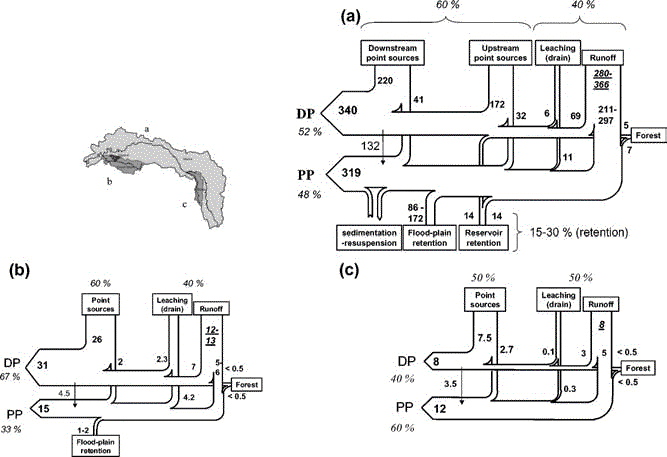NemeryiΕΜeΜͺΙLj,J.,
Garnier,J. and Morel,C.(2005): Phosphorus budget in the Marne
Watershed (France): urban vs. diffuse sources, dissolved vs. particulate
forms. Biogeochemistry, 72, 35-66.
wMarne¬ζitXjΕΜϋxFΆΉΝss©gUΉ©AΝnΆΤ©±qσ©x
wAbstract
@We evaluated the P sources (point, diffuse), through a nested
watershed approach investigating the Blaise (607 km2),
dominated by livestock farming, the Grand Morin (1202 km2),
dominated by crop farming, and the Marne (12,762 km2),
influenced by both agriculture and urbanization. Fertilizers account
for the main P inputs (60) to the soils. An agricultural P surplus
(0.5-8 kg P ha-1 year-1) contributes to
P enrichment of the soil. The downstream urbanized zone is dominated
by point sources (60, mainly in dissolved forms), whereas in
the upstream basin diffuse sources dominate (60, mostly particulate).
Among the diffuse sources (losses by forests, drainage and runoff),
losses by runoff clearly dominate (90). P retention in the alluvial
plain and the reservoir represents 15-30 of the total P inputs.
Dissolved and particulate P fluxes at the outlet of the Marne
are similar (340 and 319 tons of P year-1, respectively).
The Blaise sub-basin receives P from point and diffuse sources
in equal proportions, and retention is negligible. The Grand-Morin
sub-basin, influenced by the urbanized zone receives, as does
to the whole Marne basin, 60 of P inputs as point sources. The
total particulate phosphorus in suspended sediments averaged 1.28
g P kg-1, of which about 60 are inorganic and 40
organic P. Particulate phosphorus exchangeable in 1 week and 1
year (32P isotopic method) accounts for between almost
26 and 54 of the particulate inorganic phosphorus in the suspended
sediment and might represent an important source of dissolved
P, possibly directly assimilated by the vegetation.
Key words: Diffuse and point sources; Dissolved and particulate
phosphorus; Eutrophication; Exchangeabilityx
Introduction
Materials and methods
@Site description and sampling
@Sample preparation and P analyses
@Determination of the amount of P ions exchanged between suspended
sediment and solution
@Statistical analyses
@Phosphorus mass balance calculations at the outlets of the sub-basins
@Point sources in the Marne watershed
@Retention of phosphorus in the flood-plain
@Retention of phosphorus in the Marne reservoir
@Diffuse sources calculations
@Agricultural phosphorus budget
@Atmospheric depositions
@Total phosphorus stock in the soil
Results
@Agricultural phosphorous budget
@Total P stock in soils
@P budget: quantification of the proportion of diffuse sources
vs. point sources
@Phosphorous content and exchangeability in re-suspended sediments
Discussion
@Agricultural phosphorous budget
@Specific phosphorus loss from runoff and leaching
@Phosphorous budget at hydrographic network scale
@Exchangeability of particulate P
Acknowledgements
References
ίι
